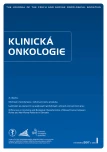Analytical Interference Leading to a Diagnosis of Lymphoproliferative Disorder
Authors:
I. Kurfürstová 1; T. Šálek 1; E. Kadlčková 2; M. Pšenčík 1
Authors‘ workplace:
Oddělení klinické biochemie a farmakologie, Krajská nemocnice T. Bati, a. s.
1; Hematologicko-transfuzní oddělení, Krajská nemocnice T. Bati, a. s.
2
Published in:
Klin Onkol 2017; 30(1): 55-57
Category:
Case Report
doi:
https://doi.org/10.14735/amko201755
Overview
Background:
Monoclonal immunoglobulins (paraproteins) are produced by B lymphocytes in lymphoproliferative disorders. A single monoclonal immunoglobulin is homogeneous in terms of its structure, and it can occur in human serum at high concentration and cause significant interference in laboratory assays.
Case:
We present a case of an 84-year-old man who was admitted to the hospital for progression of dyspnea. Basic laboratory tests showed a serum concentration of conjugated bilirubin, measured using the diazo spectrophotometric method, which was much higher than that of total bilirubin. The cause of the discrepancy was attributed to analytical interference by monoclonal immunoglobulins, which helped establish a diagnosis of lymphoproliferative disorder.
Conclusion:
Monoclonal immunoglobulins are relatively rare in serum but are an important cause of analytical interference. Monoclonal immunoglobulins should always be considered a source of interference when unexpectedly high, low, or contradictory data are encountered, and appropriate confirmatory tests (electrophoresis, imunofixation) should be performed in such circumstances. Failure to do so can result in errors in diagnosis and inadequate treatment. Conversely, when samples contain abnormal and especially high monoclonal immunoglobulin levels, the biochemical data should be carefully examined for any discrepancies, such as paraprotein interference, and the results should be taken into consideration in patient management.
Key words:
paraproteins – lymphoproliferative disorders – bilirubin – interference
The authors declare they have no potential conflicts of interest concerning drugs, products, or services used in the study.
The Editorial Board declares that the manuscript met the ICMJE recommendation for biomedical papers.
Submitted:
22. 1. 2016
Accepted:
1. 12. 2016
Sources
1. Bakker AJ, Mücke M. Gammopathy interference in clinical chemistry assays: mechanisms, detection and prevention. Clin Chem Lab Med 2007; 45 (9): 1240–1243.
2. Dutta AK. A curious case of hyperbilirubinemia. Indian J Clin Biochem 2012; 27 (2): 200–201. doi: 10.1007/s12291-011-0160-0.
3. Hummel KM, Ahsen von N, Kühn RB et al. Pseudohypercreatininemia due to positive interference in enzymatic creatinine measurements caused by monoclonal IgM in patients with Waldenström’s macroglobulinemia. Nephron 2000; 86 (2): 188–189.
4. Yu A, Pira U. False increase in serum C-reactive protein caused by monoclonal IgM-λ: a case report. Clin Chem Lab Med 2001; 39 (10): 983–987.
5. Dimeski G, Carter A. Rare IgM interference with Roche/Hitachi modular glucose and gamma-glutamyltransferase methods in heparin samples. Clin Chem 2005; 51 (11): 2202–2204.
6. John R, Oleesky D, Issa B et al. Pseudohypercalcaemia in two patients with IgM paraproteinaemia. Ann Clin Biochem 1997; 34 (6): 694–696.
7. McCloskey EV, Galloway J, Morgan MA et al. Pseudohyperphosphataemia in multiple myeloma. BMJ 1989; 299 (6712): 1381–1382.
8. Bakker AJ. Influence of monoclonal immunoglobulins in direct determinations of iron in serum. Clin Chem 1991; 37 (5): 690–694.
9. Wu LC, Chuang SS, Lin CN et al. Multiple myeloma uncovered by investigating a negative serum iron level. J Clin Pathol 2007; 60 (1): 110.
10. Yang Y, Howanitz PJ, Howanitz JH et al. Paraproteins are a common cause of interferences with automated chemistry methods. Arch Pathol Lab Med 2008; 132 (2): 217–223.
11. Dimeski G, Bassett K, Brown N. Paraprotein interference with turbidimetric gentamicin assay. Biochem Med (Zagreb) 2015; 25 (1): 117–124. doi: 10.11613/BM.2015.014.
12. Mysliveček M, Bačovský J, Ščudla V et al. 18F-FDG PET/ /CT v diagnostice mnohočetného myelomu a monoklonální gamapatie nejistého významu: srovnání s 99mTc-MIBI scintigrafií. Klin Onkol 2010; 23 (5): 325–331.
13. Šolcová L, Friedecký B, Radocha J et al. Abnormální hyperbilirubinémie u pacientky s mnohočetným myelomem. Klin Biochem Metab 2008; 16 (37): 202–203.
Labels
Paediatric clinical oncology Surgery Clinical oncologyArticle was published in
Clinical Oncology

2017 Issue 1
- Metamizole vs. Tramadol in Postoperative Analgesia
- Metamizole at a Glance and in Practice – Effective Non-Opioid Analgesic for All Ages
- Possibilities of Using Metamizole in the Treatment of Acute Primary Headaches
- Current Insights into the Antispasmodic and Analgesic Effects of Metamizole on the Gastrointestinal Tract
- Spasmolytic Effect of Metamizole
Most read in this issue
- Lymphoedema Following Regional Lymph Node Surgery for Breast Cancer
- Epithelial-mesenchymal Transition in Tumor Tissue and Its Role for Metastatic Spread of Cancer
- Daratumumab – Hope for Myeloma Patients, a Challenge for Clinical Laboratories
- Options of Chemotherapy in the Treatment of Prostate Cancer
